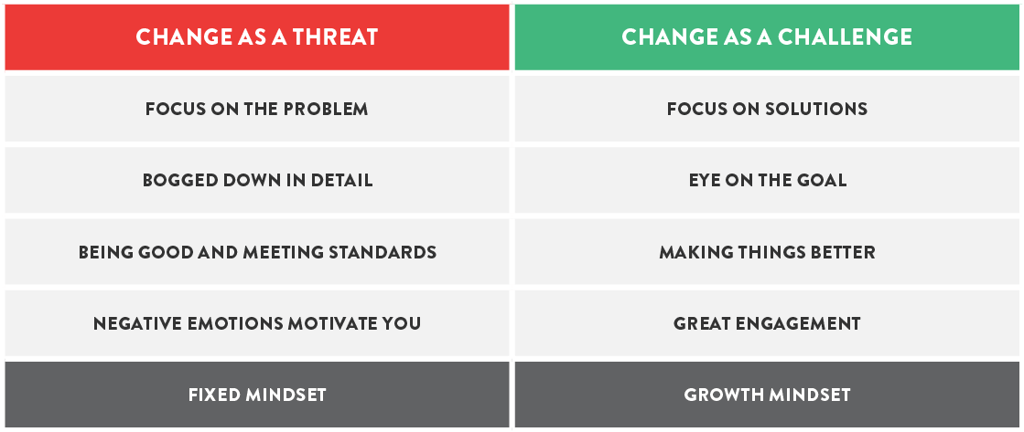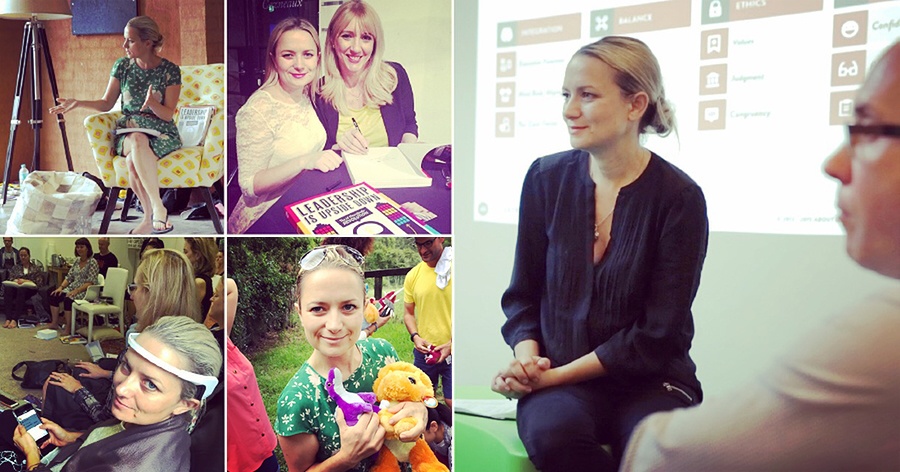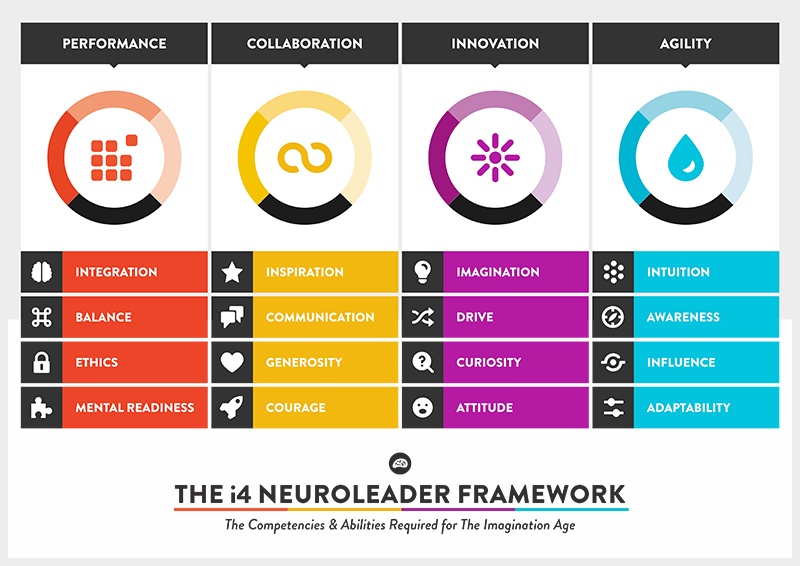Fixed Mindset: Or I Always Knew There Was Something In That Confirmation Bias!
Are we creating our own ‘fake news’ as much as others are creating this for us? Are we getting in our own way confirming our comfortable status quo and creating a false sense of security or are we seeking to challenge our perspectives and position and be more receptive and agile - a leadership competency which is critical for success today.
At Mantle, we are committed to Leadership from the Inside Out, supporting leaders to be the best they can be both now in the future, through working with mindset using a neuroscience and coaching approach.
Created by Silvia Damiano, i4 is a personal leadership model that consists of 4 key competencies with 16 underpinning pillars. The model is rather different from other leadership competency approaches because informed by contemporary neuroscience, it takes into account brain and body processes that support effective leadership practices critical for the 21st Century.
In this article we will talk about agility which refers to the capacity to read changing conditions in ones environment and the ability to adjust to them.
The rise of “false” or “alternative facts” and propaganda has led to flak for Facebook and there have been multiple US and UK inquiries into the growing phenomenon of “fake news”. Yet the disconnect between the “truth” and how we see and read it has always been there. In fact it is built into our brain biology and this capacity to build a fixed mindset is one of the reasons why we struggle to adapt to change.
We are continually bombarded with new information and changing circumstances in our personal and professional lives, probably more than at any stage of human history and that represents quite a challenge for anyone trying to lead themselves or others.
So if, however reluctantly, we accept change as a constant – think of software auto-updates, upgrades to apps, new product ranges and formulations on supermarket shelves – we need to find ways of navigating this ‘new norm’ to succeed.
We need to be agile.
Agility is the capacity to read changing conditions in one’s environment and the ability to respond to them.
We would like to start with a common misconception about how our brains operate which sheds light on the “fake news” phenomenon and explains in part our sometimes lack of agility when facing change. When we read something, we tend to think it’s a process of “information transfer” from the outside world into our brain. But that’s not the way perception works at all.
To a large degree, our sense of the world is our unique hypothesis that we generate from experience, expectations and beliefs – already held internal information. Reading and watching the news is simply a bit of feedback that supports what we believe is happening anyway. We have always created our own “fake news”, we don’t need other people to do this for us.
You may have already come across it as confirmation bias and it sits at the heart of how our brains try and make sense of the world and try to make sense of complex or new information.
It is the challenge of making assumptions to move forward and yet being able to instinctively and wisely hold up those assumptions for challenge. It’s the challenge of being decisive and yet being open to others perspectives. In a sense, it is being good at balancing your internal strongly held views or mindset whilst grasping the new realities of a changing situation.
We call this leadership from the inside out and it is all about the importance of having the right mindset.
Without a doubt the best research done to date on how we respond to change is represented by the growth and fixed mindset concepts from Dr. Carol Dweck.
Our brains have evolved to being organised around avoiding threats and maximising rewards so it’s perhaps not surprising that our mindset will dictate whether we see any change as a threat or a challenge and our behaviours flow from that perspective.
This is important because these days all management is change management and all leadership is change leadership.

So, if you want to improve your agility you need to work on your awareness, your own growth mindset, keeping improving and inspire others. If you can’t see change as a challenge (as opposed to a threat) to move forward then you can’t lead yourself or others.
Practice 1.
Become more aware
This is all about paying attention to what matters. By doing this we are able to take in more information about the task at hand, ignoring the noise and distractions. It may be about providing support to your people to work in a quiet space and to help build their attentional self-control.
Our brain’s default network is focused on the past, the future and social encounters and is busy. This is not a bad thing. It just is. In order to be present and mindful we need to switch this off and turn on the direct experience pathway.
Another couple of methods for enhancing awareness involve external focus – being open to feedback and strategic thinking. Feedback should be rapid, open and direct allowing for fast correction. This allows people to learn and correct course on the fly. Strategic thinking is about being able to take a wide view, put yourself in others shoes and look ahead at possibilities, understanding your environment.
Practice 2.
Develop a growth mindset
This means benchmarking against your current self and putting in plans and processes to try new things, get feedback and self-correct over time so that your future self-becomes your new improved current self.
It is true some of us are born being better or worse than others at dealing with, for example, people or computers or numbers. It is also true that with effort we can all get better, telling yourself you are not a people person is not supporting your right mindset for change and your brain will attempt to pattern recognise and serve you up with exactly what you expect.
Try and think of your current strengths as weaknesses you have already developed and your weaknesses are strengths you have yet to develop.
Try and shift your focus onto solutions rather than problems. Solutions’ thinking usually requires deeper and new thinking. Practice nudging your attention away from the problem and irrelevant detail, and focus more towards solutions and outcomes. You can learn to broaden your thinking approaches by using frameworks such as collaborative problem-solving.
Find ways to get safe and useful feedback from others. We all have our own unique view (and blind spots) so be open to possibilities and tap into others perspectives.
Increasingly the world of work is complex and full of ambiguity. We can no longer use just our prefrontal cortex (PFC) to plan, organise, decide and think through linear problem-solving.
Practice 3.
Continuously improve
We need to be able to better tap into our imagination and creativity. This requires a more integrated whole brain approach that relies on listening to intuition to have our ‘aha’ moments – those insights which bring thinking together in new ways. We have a ‘sense of knowing’ when we get a right answer.
How can you support being more creative?
- Building in short periods of reflection to work in a quiet space for “thinking about thinking”
- Learning journals and reflective discussions with mentors and coaches.
- Creating a positive mental state.
- Formulating the right question to be answered.
- Reflection by focusing on the future state.
- Quietening the mind by letting go of the problem and taking a break.
- Practice meditation.
- Taking up a creative hobby
- Learn a new skill or field of knowledge
From a structural perspective take a scientific approach and conduct small experiments and measure the outcomes. This can be as simple as something like changing your meeting formats to improve engagement.
As you develop your new meeting approach get clear on how you might measure your outcomes and put evaluation and review process in place. When you have successfully implemented something, go for a stretch in year 2 in our practice we tend to shoot for a minimum 20% improvement after a pilot or stage 1.
Practice 4.
Inspire others
If you focus on awareness, developing a growth mindset and continuous improvement, you are already role-modelling and influencing others.
If we are leading from anywhere in the organisation, we need to be able to influence using personal power as opposed to positional power. We need to be able to identify what matters and have the respect of others so that they follow and challenge as need be. Stephen Covey talks about the speed of trust. This is what will support us to get people on board with our ideas.
If you want to keep your organisation moving forward, relevant and agile, you need to change mindsets quickly to align your people with the changing direction...
No easy task!
These steps can support you:
- Help your people to identify with the purpose of the change by finding their WIFM and aligning their own beliefs and purpose with this. If our beliefs and actions are not aligned, we go through cognitive dissonance which can feel uncomfortable and so has us in a state of wanting to revert back to type in order to defend ourselves from ‘threat’.
- Ask them to be open to giving it a go. Ordering people to change and telling them how to change triggers the connection to the amygdala and we get pushback.
- Ensure the new systems/environment support the new behaviour enabling congruence and more easy habit formation.
- Support your people with the resources, tools, and skills to do the new work.
- Role-model. People follow actions more than words. Mimicry and the effect of mirror neurons continue to impact learning today.
In summary, if we are all to adapt to changing circumstances we have the right brains to do the job. We are wired to learn and can and do learn throughout our lives.
The trouble is that on the way we also learn things that can hold us back or become redundant.
The safest strategy we suggest is to cultivate a growth mindset and take responsibility for your own learning and improvement and tap into others rich perspectives. Any effective leader will tell you that all good leaders are a work in progress.
Originally Published by Mantle
- i4 Neuroleader (353)
- Leadership & Culture (325)
- Brain Health & Wellbeing (202)
- Innovation (97)
- Performance (85)
- Our News (80)
- Collaboration (68)
- Agility (53)
- Practitioner Stories (44)
- In The Press (36)
- Make Me A Leader (33)
- Balance (31)
- Integration (30)
- Imagination (29)
- Awareness (23)
- Brain-Friendly Channel (22)
- Communication (22)
- Curiosity (21)
- Inspiration (19)
- Intuition (19)
- Attitude (17)
- Courage (16)
- Adaptability (14)
- Case Studies (14)
- Drive (14)
- Generosity (13)
- Brain-Friendly Leadership (11)
- Ethics (9)
- Mental Readiness (9)
- Influence (8)
- Retreat (6)
- Brain-Friendly Leadership (1)
- Oracle Cards (1)
- 1 April 2025 (1)
- 1 March 2025 (9)
- 1 February 2025 (3)
- 1 September 2024 (4)
- 1 July 2024 (2)
- 1 June 2024 (6)
- 1 May 2024 (2)
- 1 April 2024 (3)
- 1 March 2024 (1)
- 1 November 2023 (1)
- 1 August 2023 (1)
- 1 July 2023 (2)
- 1 June 2023 (2)
- 1 May 2023 (4)
- 1 April 2023 (2)
- 1 March 2023 (7)
- 1 February 2023 (4)
- 1 January 2023 (1)
- 1 September 2022 (1)
- 1 May 2022 (3)
- 1 April 2022 (1)
- 1 March 2022 (5)
- 1 February 2022 (4)
- 1 January 2022 (4)
- 1 December 2021 (2)
- 1 November 2021 (4)
- 1 October 2021 (3)
- 1 September 2021 (6)
- 1 August 2021 (1)
- 1 April 2021 (1)
- 1 December 2020 (2)
- 1 November 2020 (1)
- 1 September 2020 (1)
- 1 August 2020 (1)
- 1 July 2020 (3)
- 1 June 2020 (4)
- 1 May 2020 (3)
- 1 April 2020 (4)
- 1 March 2020 (6)
- 1 February 2020 (4)
- 1 January 2020 (2)
- 1 December 2019 (3)
- 1 November 2019 (3)
- 1 October 2019 (5)
- 1 September 2019 (4)
- 1 August 2019 (4)
- 1 July 2019 (4)
- 1 June 2019 (5)
- 1 May 2019 (9)
- 1 April 2019 (9)
- 1 March 2019 (8)
- 1 February 2019 (7)
- 1 January 2019 (8)
- 1 December 2018 (5)
- 1 November 2018 (10)
- 1 October 2018 (16)
- 1 September 2018 (9)
- 1 August 2018 (10)
- 1 July 2018 (9)
- 1 June 2018 (8)
- 1 May 2018 (9)
- 1 April 2018 (9)
- 1 March 2018 (9)
- 1 February 2018 (8)
- 1 January 2018 (8)
- 1 December 2017 (6)
- 1 November 2017 (9)
- 1 October 2017 (9)
- 1 September 2017 (8)
- 1 August 2017 (10)
- 1 July 2017 (8)
- 1 June 2017 (8)
- 1 May 2017 (9)
- 1 April 2017 (8)
- 1 March 2017 (6)
- 1 January 2017 (3)
- 1 December 2016 (4)
- 1 November 2016 (5)
- 1 October 2016 (4)
- 1 September 2016 (2)
- 1 August 2016 (4)
- 1 July 2016 (4)
- 1 June 2016 (2)
- 1 May 2016 (3)
- 1 April 2016 (3)
- 1 March 2016 (7)
- 1 February 2016 (2)
- 1 January 2016 (5)
- 1 December 2015 (2)
- 1 November 2015 (2)
- 1 October 2015 (4)
- 1 September 2015 (2)
- 1 August 2015 (2)
- 1 July 2015 (1)
- 1 June 2015 (3)
- 1 May 2015 (4)
- 1 April 2015 (5)
- 1 March 2015 (3)
- 1 February 2015 (3)
- 1 January 2015 (3)
- 1 December 2014 (3)
- 1 November 2014 (3)
- 1 October 2014 (3)
- 1 September 2014 (5)
- 1 August 2014 (4)
- 1 July 2014 (5)
- 1 June 2014 (3)
- 1 May 2014 (1)
- 1 March 2014 (1)
- 1 December 2013 (2)
- 1 November 2013 (1)
- 1 July 2013 (1)
- 1 June 2013 (1)
- 1 May 2013 (3)
- 1 April 2013 (1)
- 1 March 2013 (2)
- 1 February 2013 (1)
- 1 January 2013 (2)
- 1 November 2012 (1)
- 1 October 2012 (1)
- 1 September 2012 (1)
- 1 August 2012 (2)
- 1 July 2012 (1)
- 1 June 2012 (1)
- 1 May 2012 (2)
- 1 April 2012 (1)
- 1 February 2012 (1)
- 1 January 2012 (1)
- 1 November 2011 (1)
- 1 October 2011 (3)
- 1 September 2011 (2)
- 1 July 2011 (1)
- 1 June 2011 (1)
- 1 May 2011 (1)
- 1 April 2011 (1)
- 1 March 2011 (1)
- 1 February 2011 (2)
- 1 January 2011 (4)
- 1 December 2010 (4)
- 1 November 2010 (3)
- 1 October 2010 (5)
- 1 September 2010 (4)
- 1 August 2010 (4)
- 1 July 2010 (3)
- 1 June 2010 (4)
- 1 May 2010 (7)
- 1 April 2010 (5)
Subscribe by email
You May Also Like
These Related Stories

Eureka! - Go Deep

Key Insights From An i4 Practitioner For Creating A Brain-Friendly Culture





No Comments Yet
Let us know what you think